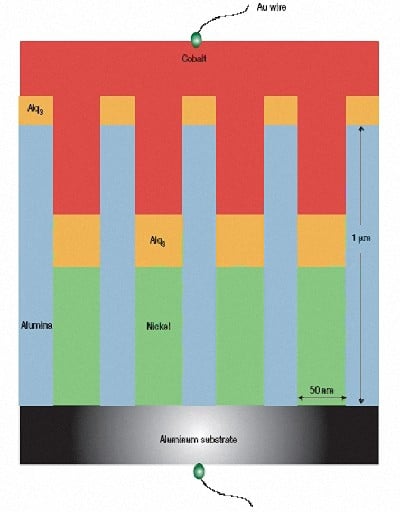Engineers in the US have discovered that the spin of electrons in organic nanowire "spin valves" is extremely robust. A team of researchers from Virginia Commonwealth University and the University of Cincinnati have found that the "spin-relaxation time" in these wires is at least 1000 times longer than that reported in any other system. The result means that these materials could be ideal for use in spintronics, an emerging field that exploits the spin of the electron to encode information in electronic circuits, computers and other devices (Nature Nanotechnology doi:10.1038/nnano.2007.64).

To store and process information using the spin of an electron, the spin needs to be relatively robust. The most important property that determines a spin’s robustness is its spin-relaxation time. When a spin relaxes – something that can happen when the spin is perturbed by interactions with its environment – the information encoded in the spin is lost. “We therefore want the relaxation time to be as long as possible,” said Virginia team member Supriyo Bandyopadhyay.
The researchers made a 50 nm diameter spin valve – a device whose resistance changes in a magnetic field because of spin-related effects. The valve consists of a thin layer of an organic semiconductor, tris (8-hydroxyquinoline), sandwiched between two ferromagnetic electrodes made of cobalt and nickel. The team was able to determine the spin-relaxation time in the organic nanowire by measuring the change in the resistance.
Typically the spin-relaxation time in most materials is a few nanoseconds to a few microseconds, but the researchers found that the spin relaxation in their organic nanowire spin valves could be as long as a second. Moreover, it was relatively unaffected by temperatures up to 100 K.
According to the team, the spin relaxation in their material is very long because the spin tends to remain relatively isolated from perturbations that cause it to relax. They also found that the principal spin-relaxation mechanism is one where the spin relaxes when the electron collides with another electron, or any other obstacle, when moving though the material. This discovery could allow researchers to find new ways to make the spin-relaxation time even longer.
“The organic spin valves we developed are based on self-assembled structures grown on flexible substrates, which could have a tremendous impact on the rapidly developing field of plastic electronics, such as flexible panel displays,” said Cincinnati team member Marc Cahay. “If the organic compounds can be replaced by biomaterials, this would also open new areas of research for biomedical and bioengineering applications, such as ultra-sensitive sensors for early detection of various diseases.”
The materials could also be suitable for opto-spintronics devices, such as spin-enhanced organic light-emitting diodes, where the spin-relaxation time must exceed the radiation recombination lifetime of excitons.



